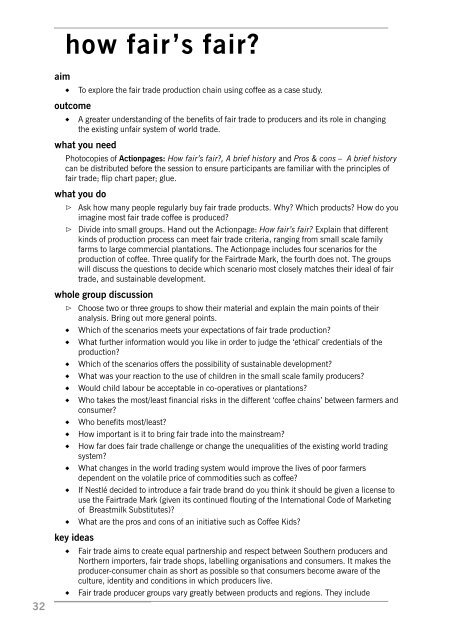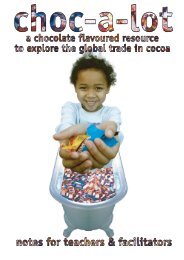Cost of coffee.indd - RISC
Cost of coffee.indd - RISC
Cost of coffee.indd - RISC
You also want an ePaper? Increase the reach of your titles
YUMPU automatically turns print PDFs into web optimized ePapers that Google loves.
aim<br />
how fair’s fair?<br />
◆ To explore the fair trade production chain using c<strong>of</strong>fee as a case study.<br />
outcome<br />
◆ A greater understanding <strong>of</strong> the benefits <strong>of</strong> fair trade to producers and its role in changing<br />
the existing unfair system <strong>of</strong> world trade.<br />
what you need<br />
Photocopies <strong>of</strong> Actionpages: How fair’s fair?, A brief history and Pros & cons – A brief history<br />
can be distributed before the session to ensure participants are familiar with the principles <strong>of</strong><br />
fair trade; flip chart paper; glue.<br />
what you do<br />
s Ask how many people regularly buy fair trade products. Why? Which products? How do you<br />
imagine most fair trade c<strong>of</strong>fee is produced?<br />
s Divide into small groups. Hand out the Actionpage: How fair’s fair? Explain that different<br />
kinds <strong>of</strong> production process can meet fair trade criteria, ranging from small scale family<br />
farms to large commercial plantations. The Actionpage includes four scenarios for the<br />
production <strong>of</strong> c<strong>of</strong>fee. Three qualify for the Fairtrade Mark, the fourth does not. The groups<br />
will discuss the questions to decide which scenario most closely matches their ideal <strong>of</strong> fair<br />
trade, and sustainable development.<br />
whole group discussion<br />
s Choose two or three groups to show their material and explain the main points <strong>of</strong> their<br />
analysis. Bring out more general points.<br />
◆ Which <strong>of</strong> the scenarios meets your expectations <strong>of</strong> fair trade production?<br />
◆ What further information would you like in order to judge the ‘ethical’ credentials <strong>of</strong> the<br />
production?<br />
◆ Which <strong>of</strong> the scenarios <strong>of</strong>fers the possibility <strong>of</strong> sustainable development?<br />
◆ What was your reaction to the use <strong>of</strong> children in the small scale family producers?<br />
◆ Would child labour be acceptable in co-operatives or plantations?<br />
◆ Who takes the most/least financial risks in the different ‘c<strong>of</strong>fee chains’ between farmers and<br />
consumer?<br />
◆ Who benefits most/least?<br />
◆ How important is it to bring fair trade into the mainstream?<br />
◆ How far does fair trade challenge or change the unequalities <strong>of</strong> the existing world trading<br />
system?<br />
◆ What changes in the world trading system would improve the lives <strong>of</strong> poor farmers<br />
dependent on the volatile price <strong>of</strong> commodities such as c<strong>of</strong>fee?<br />
◆ If Nestlé decided to introduce a fair trade brand do you think it should be given a license to<br />
use the Fairtrade Mark (given its continued flouting <strong>of</strong> the International Code <strong>of</strong> Marketing<br />
<strong>of</strong> Breastmilk Substitutes)?<br />
◆ What are the pros and cons <strong>of</strong> an initiative such as C<strong>of</strong>fee Kids?<br />
32<br />
key ideas<br />
◆ Fair trade aims to create equal partnership and respect between Southern producers and<br />
Northern importers, fair trade shops, labelling organisations and consumers. It makes the<br />
producer-consumer chain as short as possible so that consumers become aware <strong>of</strong> the<br />
culture, identity and conditions in which producers live.<br />
◆ Fair trade producer groups vary greatly between products and regions. They include




